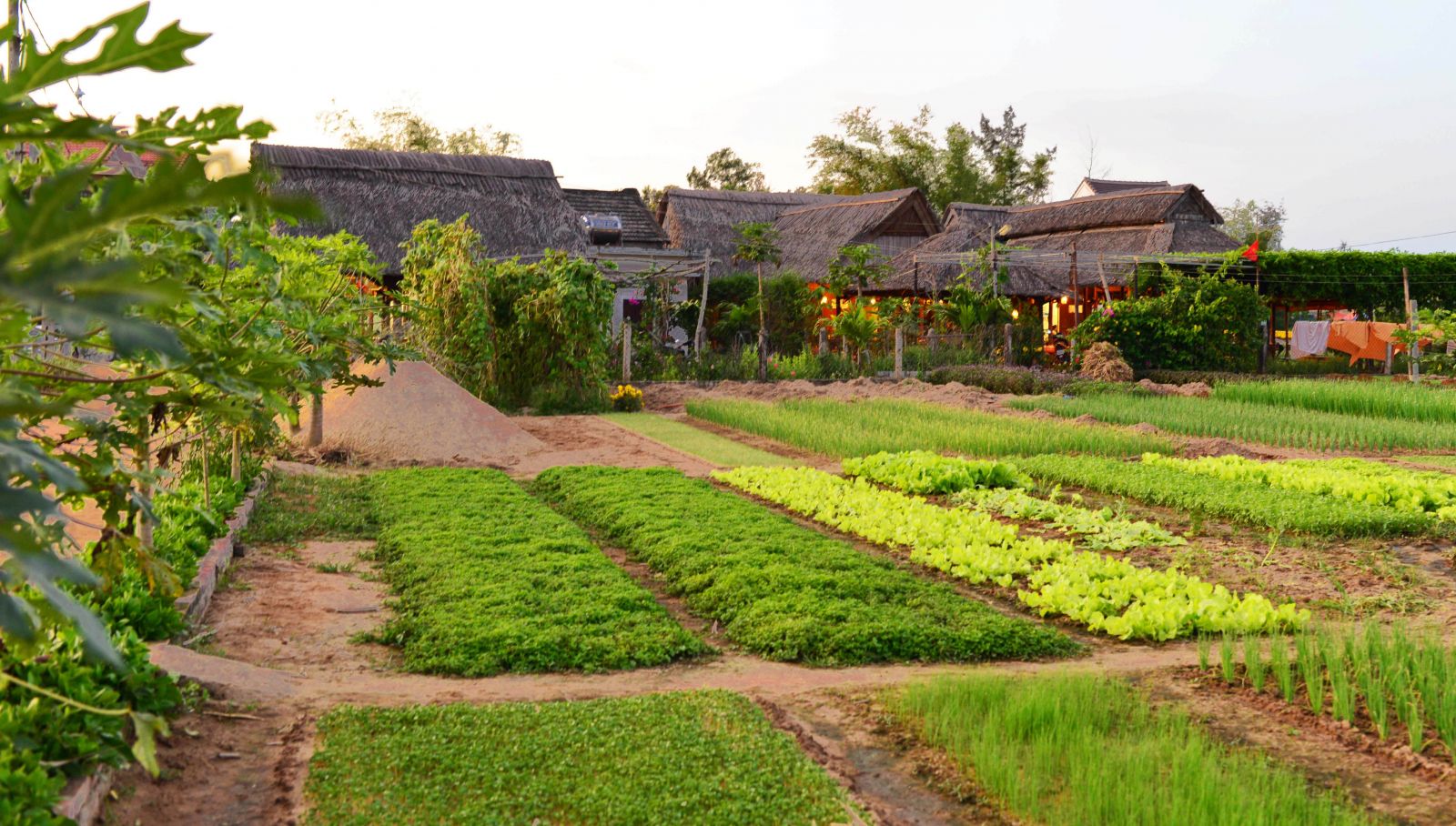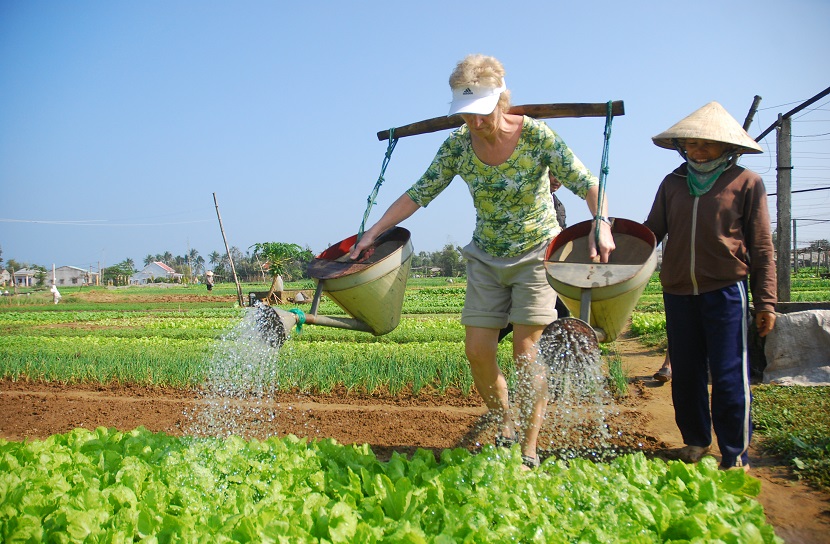Tra Que Vegetable Village – a cool and tranquil destination just 3km from the ancient town of Hoi An – has become one of the most attractive tourist spots in the city. Covering an area of over 40 hectares and with a history of cultivation spanning hundreds of years, Tra Que Vegetable Village is renowned not only for its distinctive aromatic herbs but also as a place where visitors can experience the unique agricultural culture of Quang Nam.
In this article, we will provide you with a detailed guide to exploring Tra Que Vegetable Village, from its history and formation to the exciting activities and special dishes you shouldn’t miss while visiting.
Table of Contents
History of Tra Que Vegetable Village
Origin of the Name
Tra Que Vegetable Village has a long and fascinating history. Originally named Như Quế, which refers to the scent of the vegetables grown here being similar to that of cinnamon, the village was later renamed. In the 19th century, during a visit to enjoy dishes made from the village’s vegetables, Emperor Gia Long was deeply impressed by the unique flavor and the refined vegetable cultivation techniques of the locals. The emperor decided to rename the village to Tra Que, a name that has persisted to this day.

Recognition as a National Intangible Cultural Heritage
April 4, 2023, marked a significant milestone in the history of Tra Que Vegetable Village when Minister of Culture, Sports, and Tourism Nguyen Van Hung signed a decision recognizing Tra Que vegetable cultivation as a National Intangible Cultural Heritage under the category of “Folk Knowledge, Traditional Craft”. This recognition is not only a point of pride for the village residents but also a valuable opportunity to promote and enhance the village’s brand, contributing to the upcoming recovery of tourism in Hoi An.

Unique Features of Tra Que Vegetable Village
Convenient Geographical Location
Tra Que Vegetable Village is located beside the Co Co River, a highly advantageous geographical position. The freshwater from this river contributes to the lush, thriving vegetable fields. With only 3km from the ancient town of Hoi An and 20km from Da Nang, Tra Que Vegetable Village is situated on a convenient transportation route, making it easy for visitors to visit and explore.
Diverse Aromatic Vegetables
Covering over 40 hectares, Tra Que Vegetable Village cultivates more than 20 different types of vegetables. The most notable are the aromatic herbs such as basil, cilantro, perilla leaves, and Vietnamese mint, among others. This diversity creates a vibrant tapestry of flavors: spicy, bitter, astringent, sour, and sweet, intermingling to offer a rich sensory experience.

Unique Cultivation Methods
A distinctive feature of Tra Que’s vegetable cultivation is the use of fertilizer made from seaweed collected from the Co Co River. Combined with modern vegetable-growing techniques, this method produces vegetables that are not only lush and thriving but also have a unique flavor that can’t be found elsewhere. The closed cultivation process, which avoids chemicals and pesticides, ensures that the vegetables are ultra-clean, safe for consumers, and environmentally friendly.
Tra Que Vegetable Village Tour Itinerary
After planning your visit to Hoi An Ancient Town, here is a suggested itinerary for exploring Tra Que Vegetable Village:
Morning: Explore the Scenery and History
8:00 – 9:00: Arrive at Tra Que Vegetable Village Start your visit to Tra Que Vegetable Village early in the morning. This is the ideal time to enjoy the beauty of the lush green vegetable beds under the morning sun and fresh air.
9:00 – 10:30: Visit Historical Sites With an entry fee of 35,000 VND, you can explore the village’s important historical sites:
- Nguyen Dien’s Tomb: The resting place of a renowned official who made significant contributions during the reigns of Emperors Minh Mang, Thieu Tri, and Tu Duc.
- Tra Que Stone Well: Built during the Champa period, this stone well provided fresh water for the local residents and is a testament to the village’s long history.
10:30 – 12:00: Observe Cultivation Processes Take time to watch local farmers as they work on soil preparation, applying seaweed fertilizer, planting vegetables, and watering. This is a great opportunity to understand the unique cultivation methods of Tra Que Vegetable Village.
Lunch: Experience Farming and Cuisine
12:00 – 13:30: Lunch at a Local Restaurant Enjoy lunch at a local restaurant where you can taste dishes made from fresh Tra Que vegetables. Don’t miss the chance to try Tam Huu – a must-try specialty of the region.
13:30 – 15:30: Farming Experience Join the “A Day as a Tra Que Farmer” tour for a unique experience of local farming life. Activities include:
- Carrying fertilizer for the vegetables
- Participating in vegetable care activities such as watering and fertilizing
- Harvesting vegetables
This activity not only provides enjoyment but also helps you appreciate the hard work and passion of the village’s farmers.
Afternoon: Cooking Class and Relaxation
15:30 – 17:00: Cooking Class Participate in a short cooking class where you will learn how to prepare delicious specialties of Quang Nam using fresh ingredients harvested from Tra Que’s vegetable garden.
17:00 – 18:00: Relax and Watch the Sunset Conclude your visit by relaxing among the vegetable beds, enjoying the stunning sunset over the fields, and sipping a refreshing glass of Tra Que basil seed drink.

Special Dishes at Tra Que Vegetable Village
Tam Huu
A must-try specialty when visiting Tra Que Vegetable Village, Tam Huu combines three main ingredients:
- Shrimp: Representing aquatic life
- Pork: Representing land animals
- Tra Que Vegetables: The renowned produce of the village
The harmonious blend of the natural sweetness of shrimp and pork with the refreshing aroma of Tra Que’s herbs creates a distinctive dish that reflects the close bond and affection of the land and waters.
Mi Quang
Mi Quang, a famous specialty of Quang Nam, paired with the ultra-fresh vegetables from Tra Que, offers a uniquely unforgettable flavor. This dish is a wonderful fusion of thick noodles, rich broth, and fresh Tra Que herbs.
Salads and Goi
With a variety of fresh and diverse vegetables, Tra Que Vegetable Village is the perfect place to enjoy flavorful salads and goi (Vietnamese-style salads). These dishes are not only delicious but also highly nutritious, allowing you to fully appreciate the natural taste of Tra Que vegetables.


Notes for Visiting Tra Que Vegetable Village
- Best Time to Visit: It’s recommended to visit early in the morning or late in the afternoon to avoid the intense midday heat of Central Vietnam.
- Clothing: Wear comfortable, movable clothing. It’s advisable to bring a hat, sunglasses, and sunscreen.
- Footwear: Choose suitable shoes for walking and gardening, and avoid wearing high heels.
- Respect the Environment: Do not litter and avoid damaging the vegetable beds.
- Ask Before Taking Photos: Always ask for permission from local residents before taking photos of them or their gardens.
- Shop Responsibly: If purchasing vegetables or local products, negotiate a fair price to support the local community.
- Stay Hydrated: Bring enough water, especially on hot days.
Conclusion
Tra Que Vegetable Village is more than just a typical tourist destination; it is a treasured National Intangible Cultural Heritage. With its long history, unique cultivation methods, and distinctive cuisine, the village offers visitors a cultural and culinary experience unlike any other.
From exploring historical sites and participating in farming activities to savoring local specialties, every activity at Tra Que Vegetable Village provides memorable moments.



